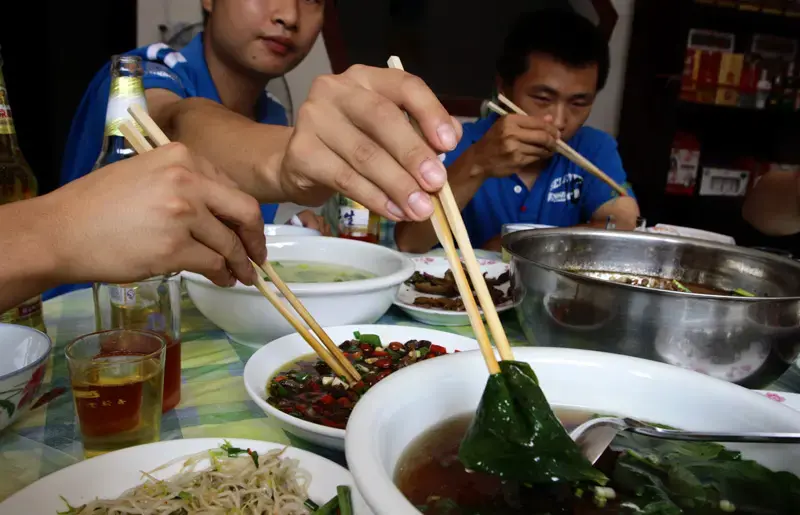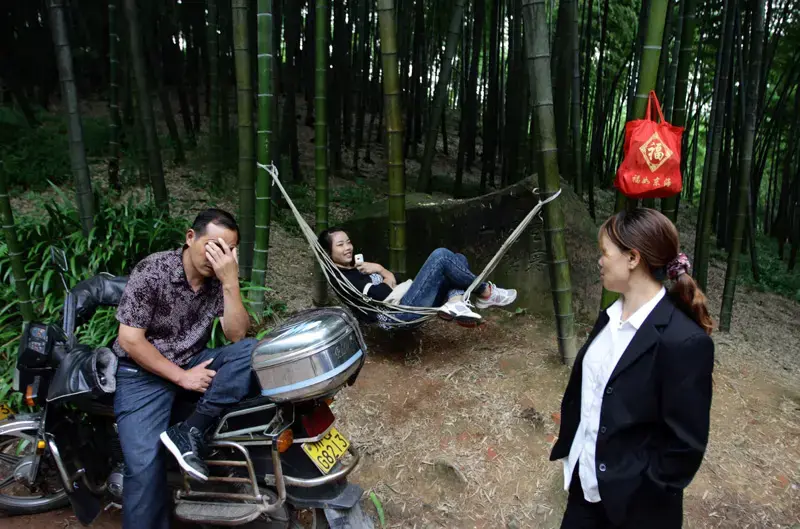The sound is deafening as metal strikes metal, battering my eardrums. Wood chips whizz past my head and the temperature seems to be rising in this small and dusty workshop. Amid the haze of sawdust, which seems to be enveloping everyone in the room, a team of workers stands over a series of archaic machines.
"Business is getting better and better each year," explains Kuai Liangyou, taking a moment of temporary silence as an opportunity to talk. "We get through nearly 800 bamboo trees a day. That's about 20 tons. The demand is very big. In the peak season, we cannot meet the demand."
Kuai is the manager of a relatively small but highly productive bamboo factory in Changning County, in southern Sichuan. This basic but efficient production line churns out a constant stream of refined bamboo, either being made into furniture or being split into new sets of disposable chopsticks. The factory is one of hundreds in the region that are trying to satisfy the appetite of the Chinese market for this new in-demand resource.
"Sichuan is one of the most densely populated regions in the country," explains Li Yanxia, Sichuan program officer for the International Network for Bamboo and Rattan (INBAR). "The rapid growth in demand for bamboo resources over the last two decades has caused excessive exploitation of forest resources in the province. This has resulted in serious disturbance and destruction of the biodiversity of ecosystems in natural bamboo forests."
In 1998, China introduced a widespread logging ban in the southwest of China, severely restricting the amount of timber cut in the region. As timber is increasingly felled in other countries to meet China's demand, domestically, attention has swiftly switched to bamboo. It's an incredibly versatile type of wood that can be made into not only chopsticks and furniture, but can also be used in construction and consumed as food. The logging ban has not been applied to bamboo, resulting in a sharp rise in demand for bamboo products.
China produces 57 billion pairs of disposable chopsticks every year, which requires over 1.18 million square meters of forest, according to the Forest Ministry's statistics from 2004 to 2009.
The UN's Food and Agricultural Organization reports that "the Chinese bamboo industry created a value of $5.5 billion in 2004. The bamboo-based GDP grew by 120 percent from 2000 to 2004, while export earnings reached $600 million, a 20 percent increase." Bamboo removal in China has grown from 260 million tons in 1990 to 1.2 billion tons in 2005. As population rises and economic development continues at a breathtaking pace, heavier pressures are being placed on the forests, continuing this trend of consumption.
"Demand is bigger than supply," says Li Yugang, the head of Jiulong village, a typical rural hamlet in southern Sichuan which is encircled by bamboo forests. He seems optimistic about the newfound potential of bamboo to bring income to his community. "The first policy was 12 years ago, which said, if you grow bamboo, the government will give you more money. Now, bamboo is 70-80 percent of income in the area. The government has encouraged local people to 'do better', to plant more bamboo in the same area."
This encouragement from the authorities, coupled with the obvious financial gains from planting and harvesting bamboo, has led to widespread over-harvesting and intensive monoculture plantations in many parts of southwest China in recent years. Unbeknownst to many locals, this has resulted in serious negative effects on local ecosystems, worrying environmental and scientific observers.
"During the past 15-20 years, a vast area of natural bamboo forests in many counties in the province has been turned into monoculture forests," says Li of IBAR. "There is an urgent need to demonstrate long-term technical and policy strategies to halt and restore the degraded biodiversity and the natural productivity of the damaged forests. The trends of monoculture forests leads to biodiversity loss and ecosystem service decrease. Local communities believe that monocultures can bring more income. To change this strong belief is the main challenge."
As demand continues to rise, the future seems decidedly uncertain for the bamboo forests of southwest China. This iconic symbol of China, a recurring feature throughout Chinese art, writing and history, is unwittingly involved in a new and impending ecological crisis that is silently gripping this region.
































